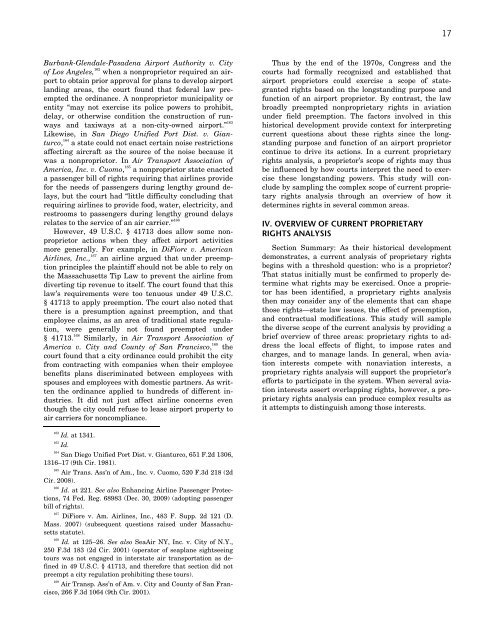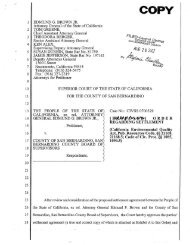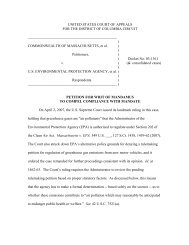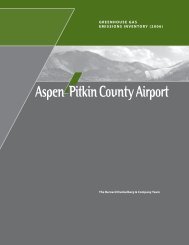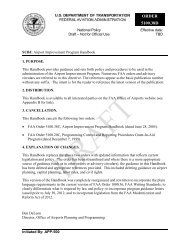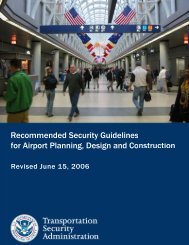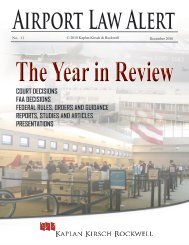ACRP Legal Research Digest 10
ACRP Legal Research Digest 10
ACRP Legal Research Digest 10
You also want an ePaper? Increase the reach of your titles
YUMPU automatically turns print PDFs into web optimized ePapers that Google loves.
17<br />
Burbank-Glendale-Pasadena Airport Authority v. City<br />
of Los Angeles, 162 when a nonproprietor required an airport<br />
to obtain prior approval for plans to develop airport<br />
landing areas, the court found that federal law preempted<br />
the ordinance. A nonproprietor municipality or<br />
entity “may not exercise its police powers to prohibit,<br />
delay, or otherwise condition the construction of runways<br />
and taxiways at a non-city-owned airport.” 163<br />
Likewise, in San Diego Unified Port Dist. v. Gianturco,<br />
164 a state could not enact certain noise restrictions<br />
affecting aircraft as the source of the noise because it<br />
was a nonproprietor. In Air Transport Association of<br />
America, Inc. v. Cuomo, 165 a nonproprietor state enacted<br />
a passenger bill of rights requiring that airlines provide<br />
for the needs of passengers during lengthy ground delays,<br />
but the court had “little difficulty concluding that<br />
requiring airlines to provide food, water, electricity, and<br />
restrooms to passengers during lengthy ground delays<br />
relates to the service of an air carrier.” 166<br />
However, 49 U.S.C. § 41713 does allow some nonproprietor<br />
actions when they affect airport activities<br />
more generally. For example, in DiFiore v. American<br />
Airlines, Inc., 167<br />
an airline argued that under preemption<br />
principles the plaintiff should not be able to rely on<br />
the Massachusetts Tip Law to prevent the airline from<br />
diverting tip revenue to itself. The court found that this<br />
law’s requirements were too tenuous under 49 U.S.C.<br />
§ 41713 to apply preemption. The court also noted that<br />
there is a presumption against preemption, and that<br />
employee claims, as an area of traditional state regulation,<br />
were generally not found preempted under<br />
§ 41713. 168 Similarly, in Air Transport Association of<br />
America v. City and County of San Francisco, 169<br />
the<br />
court found that a city ordinance could prohibit the city<br />
from contracting with companies when their employee<br />
benefits plans discriminated between employees with<br />
spouses and employees with domestic partners. As written<br />
the ordinance applied to hundreds of different industries.<br />
It did not just affect airline concerns even<br />
though the city could refuse to lease airport property to<br />
air carriers for noncompliance.<br />
Thus by the end of the 1970s, Congress and the<br />
courts had formally recognized and established that<br />
airport proprietors could exercise a scope of stategranted<br />
rights based on the longstanding purpose and<br />
function of an airport proprietor. By contrast, the law<br />
broadly preempted nonproprietary rights in aviation<br />
under field preemption. The factors involved in this<br />
historical development provide context for interpreting<br />
current questions about these rights since the longstanding<br />
purpose and function of an airport proprietor<br />
continue to drive its actions. In a current proprietary<br />
rights analysis, a proprietor’s scope of rights may thus<br />
be influenced by how courts interpret the need to exercise<br />
these longstanding powers. This study will conclude<br />
by sampling the complex scope of current proprietary<br />
rights analysis through an overview of how it<br />
determines rights in several common areas.<br />
IV. OVERVIEW OF CURRENT PROPRIETARY<br />
RIGHTS ANALYSIS<br />
Section Summary: As their historical development<br />
demonstrates, a current analysis of proprietary rights<br />
begins with a threshold question: who is a proprietor?<br />
That status initially must be confirmed to properly determine<br />
what rights may be exercised. Once a proprietor<br />
has been identified, a proprietary rights analysis<br />
then may consider any of the elements that can shape<br />
those rights—state law issues, the effect of preemption,<br />
and contractual modifications. This study will sample<br />
the diverse scope of the current analysis by providing a<br />
brief overview of three areas: proprietary rights to address<br />
the local effects of flight, to impose rates and<br />
charges, and to manage lands. In general, when aviation<br />
interests compete with nonaviation interests, a<br />
proprietary rights analysis will support the proprietor’s<br />
efforts to participate in the system. When several aviation<br />
interests assert overlapping rights, however, a proprietary<br />
rights analysis can produce complex results as<br />
it attempts to distinguish among those interests.<br />
162<br />
Id. at 1341.<br />
163<br />
Id.<br />
164<br />
San Diego Unified Port Dist. v. Gianturco, 651 F.2d 1306,<br />
1316–17 (9th Cir. 1981).<br />
165<br />
Air Trans. Ass’n of Am., Inc. v. Cuomo, 520 F.3d 218 (2d<br />
Cir. 2008).<br />
166<br />
Id. at 221. See also Enhancing Airline Passenger Protections,<br />
74 Fed. Reg. 68983 (Dec. 30, 2009) (adopting passenger<br />
bill of rights).<br />
167<br />
DiFiore v. Am. Airlines, Inc., 483 F. Supp. 2d 121 (D.<br />
Mass. 2007) (subsequent questions raised under Massachusetts<br />
statute).<br />
168<br />
Id. at 125–26. See also SeaAir NY, Inc. v. City of N.Y.,<br />
250 F.3d 183 (2d Cir. 2001) (operator of seaplane sightseeing<br />
tours was not engaged in interstate air transportation as defined<br />
in 49 U.S.C. § 41713, and therefore that section did not<br />
preempt a city regulation prohibiting these tours).<br />
169<br />
Air Transp. Ass’n of Am. v. City and County of San Francisco,<br />
266 F.3d <strong>10</strong>64 (9th Cir. 2001).


